Invasive Brain-Computer Interfaces: Advancements and Challenges
Introduction: Invasive Brain-Computer Interfaces (BCIs) represent a groundbreaking advancement in neurotechnology, allowing for direct communication between the human brain and external devices. By implanting electrodes into neural tissue, invasive BCIs facilitate unprecedented control over computer systems and prosthetic devices. They hold immense significance within the broader context of BCIs by offering solutions for individuals with severe motor impairments and providing innovative pathways for neurorehabilitation. This article delves into essential concepts surrounding invasive BCIs, their applications, current challenges, and future research directions.
Key Concepts of Invasive BCIs
Understanding Invasive BCIs requires knowledge of several major concepts:
- Neural Interfaces: Invasive BCIs utilize neural interfaces to establish direct links with brain neurons, enabling high-resolution data acquisition.
- Signal Processing: The interpretation of electrical signals produced by neurons is critical for translating thoughts into actionable commands.
- Biocompatibility: The materials used in invasive BCIs must be biocompatible to prevent rejection by the human body, ensuring long-term functionality.
Each of these elements illustrates how invasive BCIs fit seamlessly into the category of Brain-Computer Interfaces, enhancing the efficiency and effectiveness of neurotechnological applications.
Applications and Real-World Uses
Invasive BCIs have shown significant promise in a variety of practical applications. Here are some noteworthy examples:
- Prosthetic Control: Invasive BCIs allow amputees to control prosthetic limbs directly with their thoughts, providing improved functionality and precision.
- Neurorehabilitation: Individuals recovering from strokes can use invasive BCIs to regain motor control through targeted neural stimulation.
- Communication Aids: For individuals with locked-in syndrome, invasive BCIs serve as potent communication tools, enabling them to interact with the outside world.
These applications of invasive BCIs in the field of Brain-Computer Interfaces highlight their transformative potential in improving quality of life.
Current Challenges
Despite their potential, there are several challenges and limitations associated with the study and application of invasive BCIs:
- Surgical Risks: The implantation of invasive devices involves surgical procedures that carry risks of infection and complications.
- Long-term Stability: Ensuring the longevity and stability of neural interfaces within the brain remains a significant hurdle.
- Ethical Considerations: The use of invasive technology raises ethical questions about privacy, consent, and the potential for misuse.
Future Research and Innovations
Future research on invasive BCIs is poised to lead to significant innovations. Key areas of focus include:
- Miniaturization of Devices: New techniques are being developed to create smaller, more efficient BCIs that accommodate a wider range of patients.
- Enhanced Signal Processing Algorithms: Ongoing improvements in algorithms will sharpen our ability to interpret neural signals more accurately.
- Wireless Communication: Innovations in wireless technology aim to reduce the encumbrance of cables, providing greater mobility and user comfort.
Conclusion
Invasive Brain-Computer Interfaces hold immense potential for revolutionizing the field of neurotechnology. By understanding their key concepts, real-world applications, current challenges, and future research directions, we can better appreciate their significance within Brain-Computer Interfaces. As this field continues to evolve, staying informed is crucial for those interested in the intersection of neuroscience and technology. For further reading, explore our articles on neurotechnology trends and innovations in rehabilitation.


